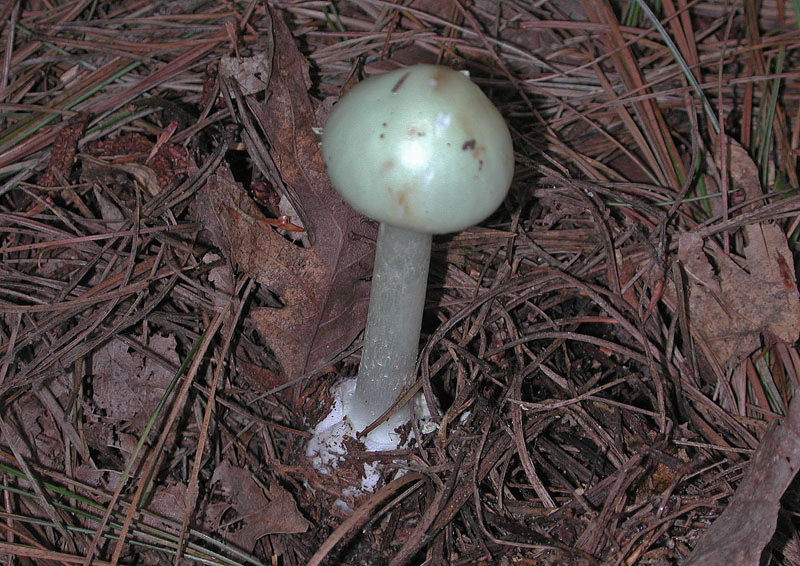Map Snapshot









38 Records
Description
Cap: Pale greenish-yellow; smooth often with random flat grayish warts; convex to nearly flat; margin may be slightly striate in age. Gills white, crowded. Stalk: White with tan stains; tapers up; large basal bulb; pendant, pale greenish-yellow ring. Parts of fruiting body may have odor of raw potatoes (J. Solem, pers. comm.).
Where To Find
Solitary or groups on ground in coniferous or mixed forests (J. Solem, pers. comm.).
Seasonality Snapshot
Source: Wikipedia
| Amanita citrina | |
|---|---|

| |
| Scientific classification | |
| Domain: | Eukaryota |
| Kingdom: | Fungi |
| Division: | Basidiomycota |
| Class: | Agaricomycetes |
| Order: | Agaricales |
| Family: | Amanitaceae |
| Genus: | Amanita |
| Species: | A. citrina
|
| Binomial name | |
| Amanita citrina | |
| Synonyms | |
|
Amanita mappa (Batsch) Bertill. | |
| Amanita citrina | |
|---|---|
| Gills on hymenium | |
| Cap is flat | |
| Hymenium is free | |
| Stipe has a ring and volva | |
| Spore print is white | |
| Ecology is mycorrhizal | |
| Edibility is poisonous or psychoactive | |
Amanita citrina (synonym Amanita mappa), commonly known as the false death cap or citron amanita,[1] is a basidiomycotic mushroom, one of many in the genus Amanita. It grows in silicate soil in the summer and autumn months. It bears a pale yellow or sometimes white cap, with white stem, ring and volva. It is an inedible mushroom due to its toxicity, but is more pertinently often confused for the lethal death cap.
Description
[edit]
This mushroom has a fleshy pale yellow, or sometimes white, cap from 4–10 centimetres (1+1⁄2–4 inches) across, covered in irregular patches. The gills and flesh are white. There is a large volva at the base of the 6–8 cm (2+1⁄2–3 in) tall stem, which has a clear ring.
The mushroom has a smell of rapeseed or potato.[2]
Similar species
[edit]It is often confused with the related Amanita phalloides, the death cap, hence the common name.[2]
Distribution and habitat
[edit]The false death cap is found in deciduous and coniferous woodlands in autumn in Europe.[2] It is also found in North American oak and pine forests.
Toxicity
[edit]This mushroom contains the alpha-amanitin toxin,[citation needed] but possibly in small enough amounts that would not cause adverse effects unless ingested at high quantity.[citation needed] It also contains the toxin bufotenin.[3] Although it is considered inedible, the biggest danger with this species is that it is marked similarity to the death. cap.[4] For further more information about DMT found in Amanita citrina see external link about the study made.
Gallery
[edit]-
A closer view of an emergent specimen
-
A. citrina from Commanster, Belgium
-
Closer view of gills and ring of a specimen from Commanster, Belgium
-
A. citrina at the 12-th countrywide mushroom exhibition 2008, Žofín, Prague, Czech Republic
-
A. citrina in Ukraine (Co-ordinates:49°19′20.03″N 28°33′29.20″E / 49.3222306°N 28.5581111°E)
See also
[edit]References
[edit]- ^ "Standardized Common Names for Wild Species in Canada". National General Status Working Group. 2020.
- ^ a b c P. Jordan & S. Wheeler (2001). The Ultimate Mushroom Book. Hermes House.
- ^ Miller Jr., Orson K.; Miller, Hope H. (2006). North American Mushrooms: A Field Guide to Edible and Inedible Fungi. Guilford, CN: FalconGuide. p. 36. ISBN 978-0-7627-3109-1.
- ^ Phillips, Roger (2010). Mushrooms and Other Fungi of North America. Buffalo, NY: Firefly Books. p. 27. ISBN 978-1-55407-651-2.
External links
[edit]- Amanita citrina on Mushroomexpert.com
- [1] Bufotenine, bufotenine–N–oxide, serotonin, N–methyl–serotonin, 5–methoxy–N,N–dimethyltryptamine, and N,N–dimethyltryptamine were identified chro–matographically in sporocarp extracts of A. citrina and, with the exception of N,N–dimethyltryptamine, in similar extracts of A. porphyria. Surface cultures of A. citrina were found to be capable of biosynthesizing bufotenine, small quantities of the alkaloid being detected in the mycelium and the culture medium.

















